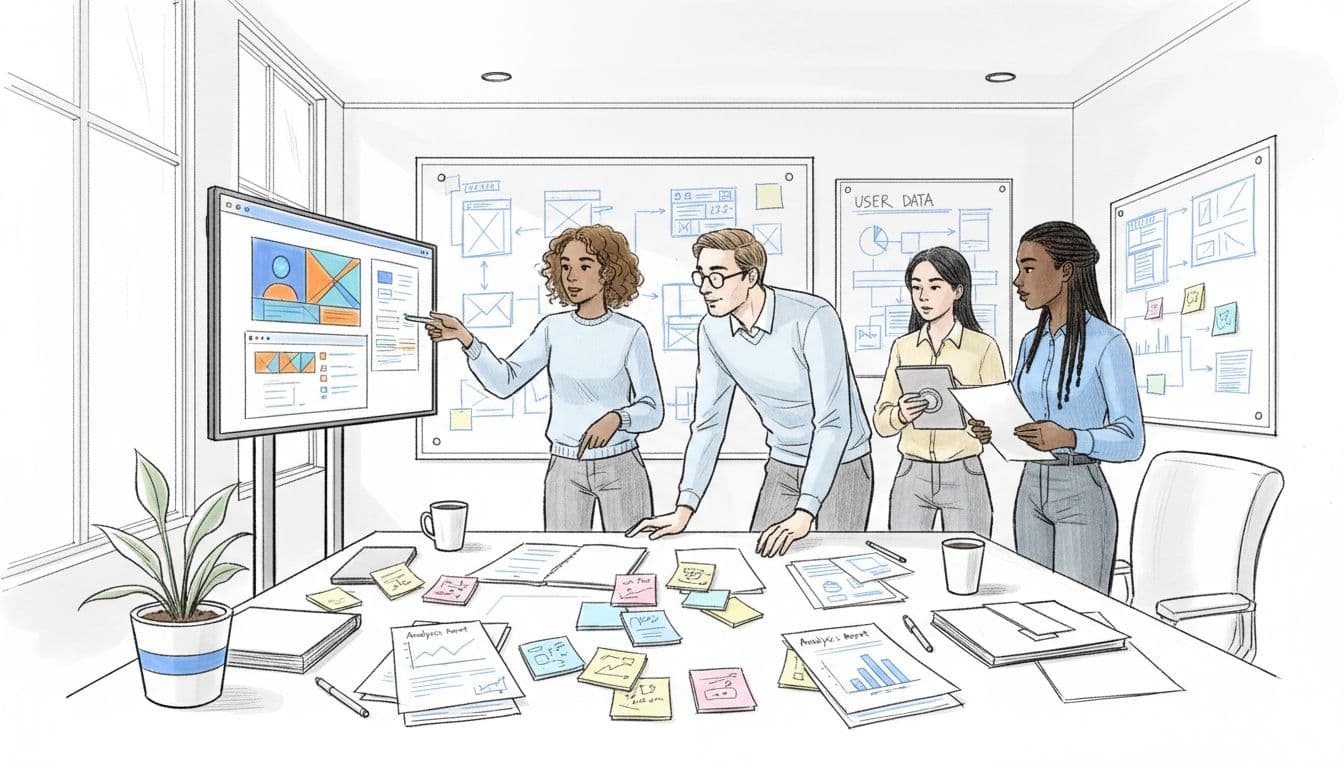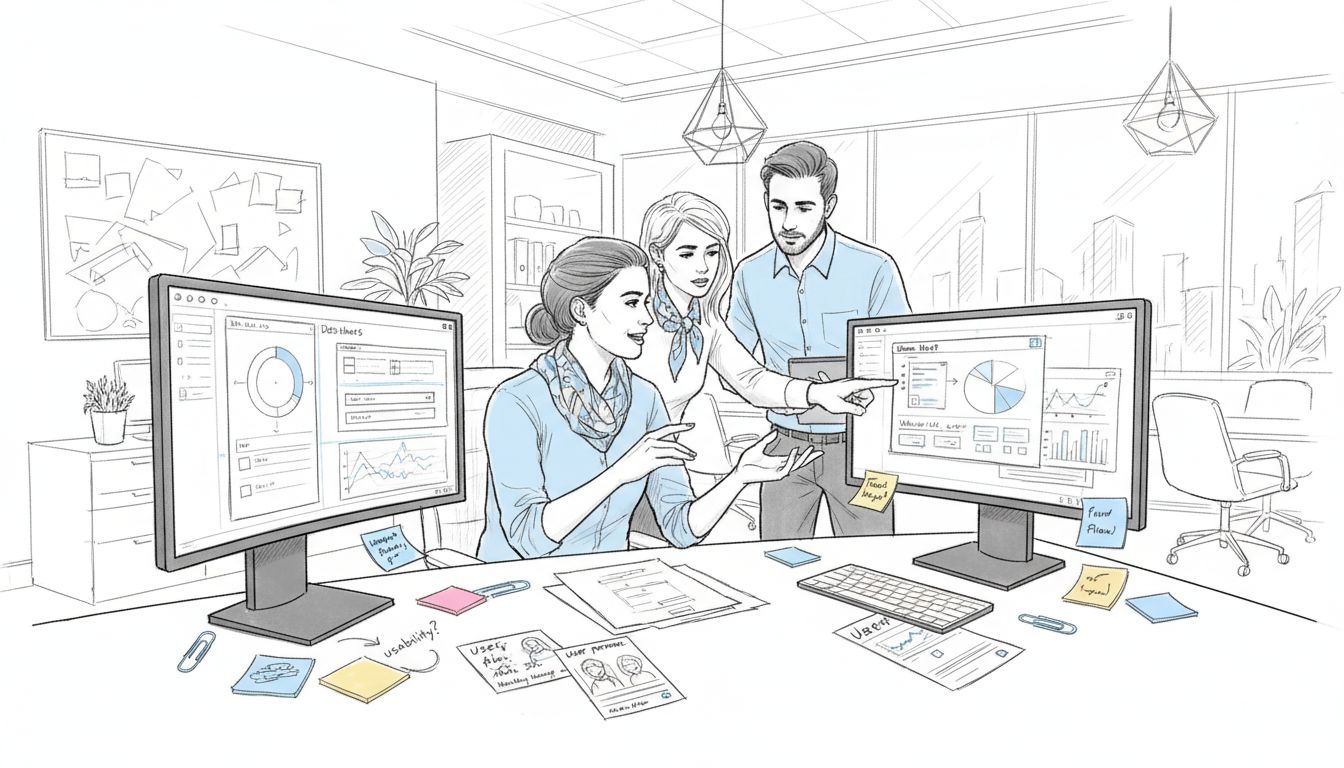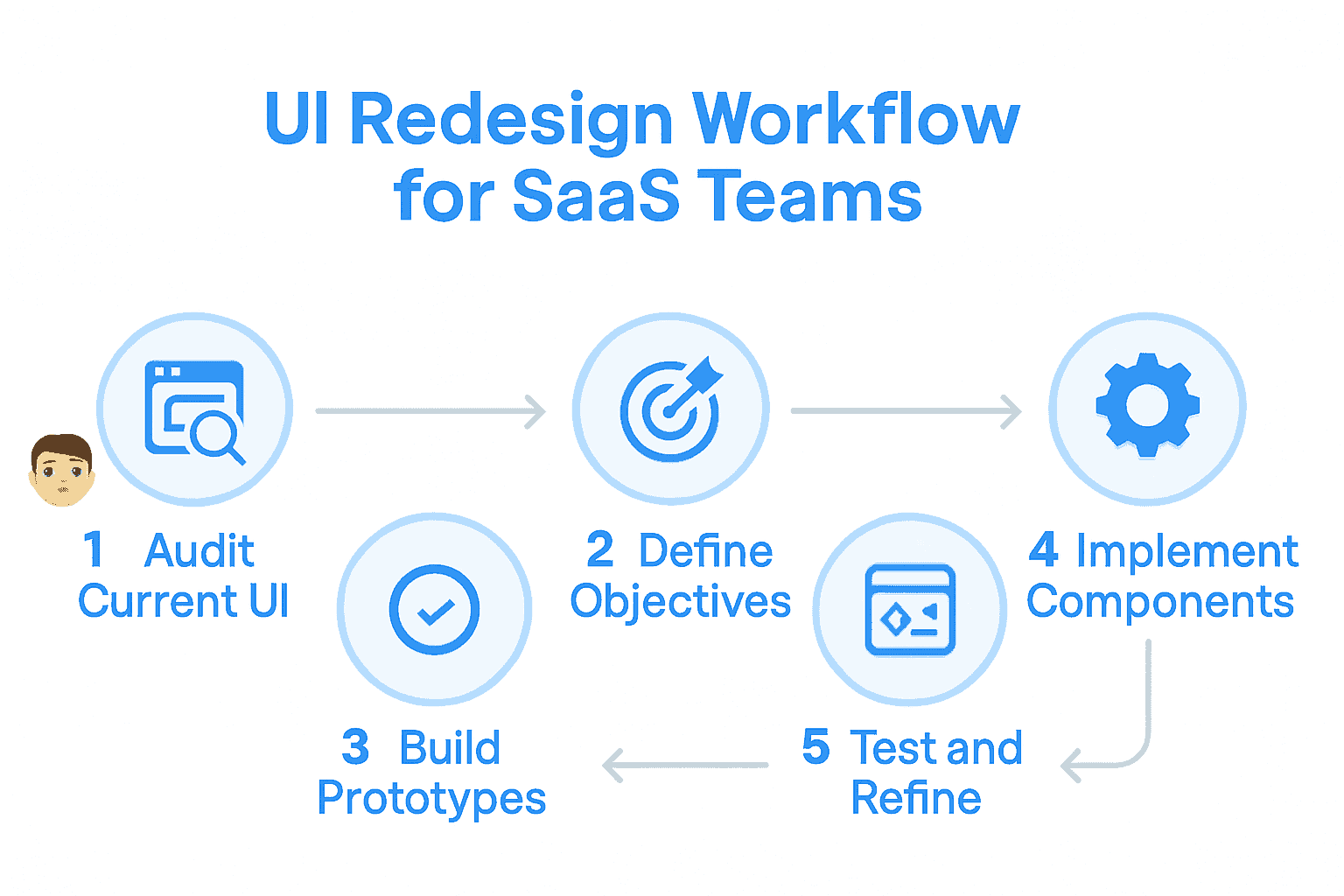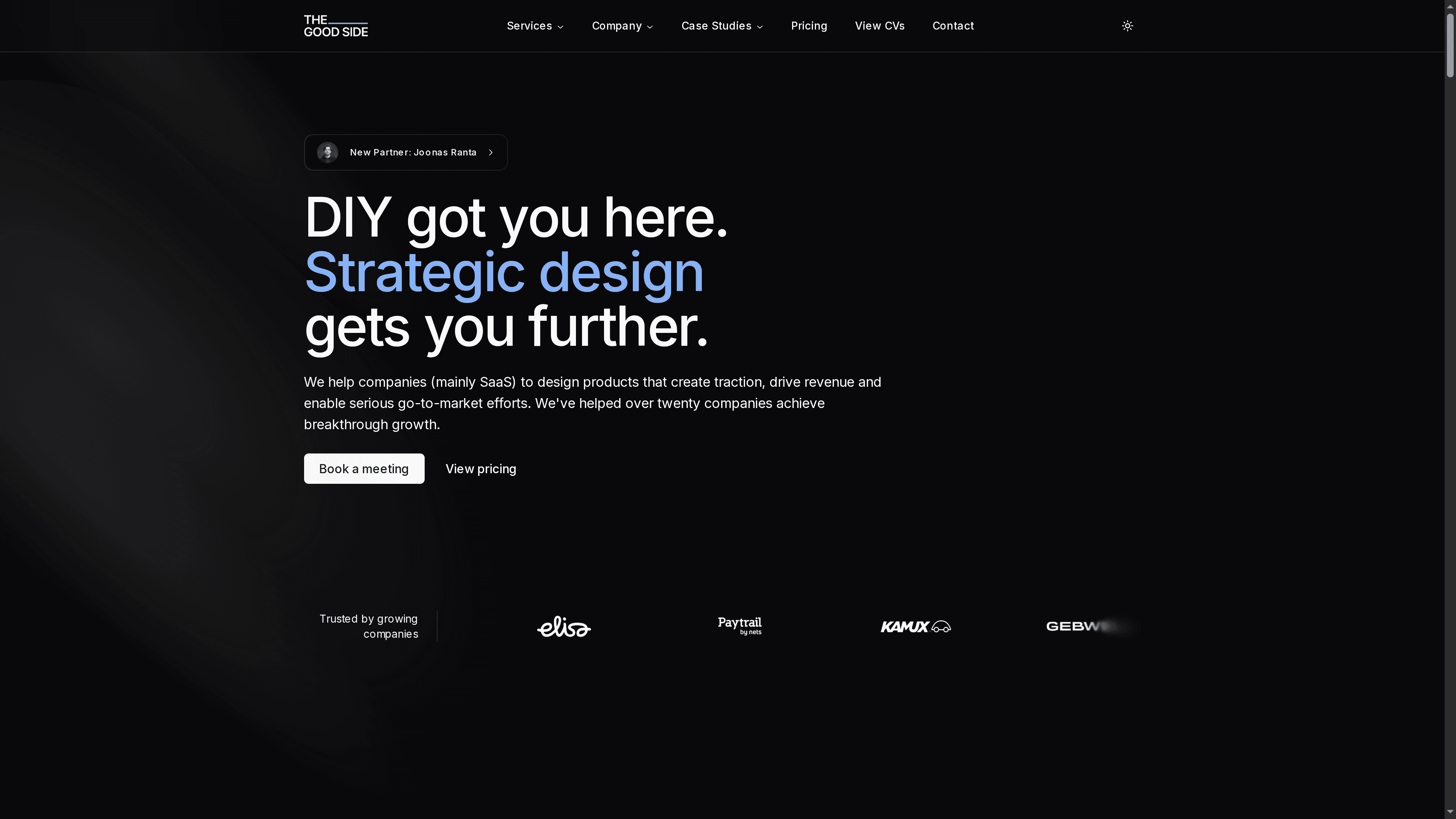UI Redesign Workflow for SaaS Teams: Step-by-Step Guide
Master the UI redesign workflow for SaaS products with this actionable, step-by-step guide—from audit and strategy to launch and verification.

Most teams spend countless hours redesigning interfaces but overlook one critical fact: over 60 percent of users will abandon a product after a poor experience. A successful UI redesign starts with a clear understanding of your users and a structured plan. Whether you want to boost engagement or solve frustration points, this guide helps you take your product from outdated to intuitive with proven steps drawn from real research and expert advice.
Table of Contents
- Step 1: Assess Current UI and Gather User Insights
- Step 2: Define Redesign Objectives and Success Metrics
- Step 3: Create Strategic UI Concepts and Prototypes
- Step 4: Implement Updated UI Components and Patterns
- Step 5: Test Redesign With Real Users and Refine
Quick Summary
| Key Point | Explanation |
|---|---|
| 1. Conduct a thorough UI audit | Review every screen and flow to identify usability issues and inconsistencies for effective design improvements. |
| 2. Establish clear redesign objectives | Transform user insights into specific goals to enhance user engagement, satisfaction, and overall experience during redesign. |
| 3. Create low to high fidelity prototypes | Start with basic wireframes and progress to interactive prototypes to address user needs while ensuring brand consistency. |
| 4. Implement a cohesive design system | Systematically integrate updated components and patterns, focusing on consistency across typography, color, and interaction elements. |
| 5. Validate designs through user testing | Conduct usability testing to gain insights on remaining issues and make targeted refinements for better user experience. |
Step 1: Assess Current UI and Gather User Insights
In this critical first stage of UI redesign, your goal is to establish a comprehensive understanding of your current user interface and uncover genuine user perspectives. By systematically analyzing your existing product and collecting targeted feedback, you will create a solid foundation for meaningful design improvements.
Start by conducting a thorough UI audit using a structured approach. Review every screen and interaction flow, documenting usability issues, visual inconsistencies, and potential friction points. According to the Wikipedia Questionnaire for User Interaction Satisfaction research, focusing on users’ subjective satisfaction with specific interface aspects can provide rich insights into design challenges.
To gather robust user insights, implement a multi method research strategy. This includes qualitative techniques like user interviews and usability testing, complemented by quantitative approaches such as satisfaction surveys and analytics review. Create a standardized feedback collection process that captures both subjective experiences and measurable user behavior. Pay special attention to areas where users struggle, drop off, or express frustration.
Pro Tip: When conducting user research, remain neutral and avoid leading questions that might bias participant responses.
Your next step after collecting these insights will be synthesizing the data into clear design recommendations that address real user needs and pain points.
Step 2: Define Redesign Objectives and Success Metrics
In this crucial phase of your UI redesign workflow, you will transform the insights gathered from user research into clear strategic objectives and measurable outcomes. Your goal is to create a precise roadmap that aligns design improvements with tangible business results.
According to AI Journ, establishing success metrics is fundamental to a successful website redesign. Start by defining specific objectives that address the key pain points uncovered in your initial user research. These might include improving user engagement, reducing onboarding time, increasing conversion rates, or enhancing overall user satisfaction.
Craft a set of quantitative and qualitative metrics that will help you measure the impact of your redesign. Quantitative metrics could include conversion rate, time on page, user retention, and task completion speed. Qualitative metrics might involve user satisfaction scores, net promoter scores, and feedback sentiment. Ensure these metrics are SMART specific, measurable, achievable, relevant, and time-bound.
Pro Tip: Prioritize metrics that directly connect to your core business goals and user experience improvements.
With your objectives and success metrics clearly defined, you are now prepared to move forward with creating a strategic design approach that will transform your product’s user interface.
Step 3: Create Strategic UI Concepts and Prototypes
In this pivotal stage of your UI redesign workflow, you will transform your research insights into tangible design concepts that reimagine your product’s user interface. Your goal is to develop strategic prototypes that not only address user pain points but also align with your established objectives and success metrics.
Begin by creating low fidelity wireframes that map out core user flows and interface structures. These initial sketches should focus on functionality and layout rather than detailed visual design. Effective UI Design Steps for High-Converting SaaS Products emphasizes the importance of iterative design approaches that prioritize user experience and strategic problem solving.
Progress from low fidelity wireframes to high fidelity interactive prototypes using design tools like Figma or Sketch. Develop multiple concept variations that explore different approaches to solving user interface challenges. Ensure each prototype addresses specific user needs identified during your research phase and maintains consistency with your brand identity and design system.

Pro Tip: Create prototypes that are flexible enough to allow quick modifications based on potential user feedback.
With your strategic UI concepts and prototypes developed, you are now ready to validate these designs through comprehensive user testing and iterative refinement.
Step 4: Implement Updated UI Components and Patterns
In this critical implementation phase of your UI redesign workflow, you will transform your strategic prototypes into a cohesive and functional design system. Your goal is to systematically integrate updated UI components that enhance user experience while maintaining visual and interactive consistency across your product.
According to Orases, successful UI component deployment requires structured team coordination and clear communication. Begin by establishing a comprehensive design system that defines precise guidelines for typography, color palettes, button styles, spacing, and interactive states. Flowjam emphasizes the importance of maintaining consistency in elements like buttons, colors, and fonts to build user trust and create a seamless experience.
Implement your design system incrementally, starting with foundational components such as typography, color schemes, and basic interactive elements. Create reusable component libraries in your design and development tools that ensure team wide alignment. Test each component thoroughly across different devices and screen sizes to guarantee responsive behavior and visual fidelity.
Pro Tip: Document every design decision and component specification to facilitate smooth collaboration between design and development teams.
With your updated UI components and patterns implemented, you are now prepared to validate the design through comprehensive user testing and iterative refinement.
Step 5: Test Redesign with Real Users and Refine
In this pivotal stage of your UI redesign workflow, you will validate your updated design through comprehensive user testing and gather actionable insights that will drive meaningful improvements. Your goal is to understand how real users interact with your new interface and identify any remaining friction points or usability challenges.
Design a robust user testing protocol that includes both qualitative and quantitative evaluation methods. Advantages of UX Research for SaaS Companies highlights the critical role of systematic user research in uncovering genuine user experiences. Conduct moderated usability testing sessions where participants complete specific tasks while thinking aloud, allowing you to observe their interactions and emotional responses in real time.
Collect and analyze both quantitative metrics like task completion rates and time on task, as well as qualitative feedback through structured interviews and surveys. Create a comprehensive feedback matrix that categorizes insights into critical issues requiring immediate attention, minor improvements, and potential future enhancements. Prioritize changes based on their potential impact on user experience and alignment with your original redesign objectives.
Pro Tip: Recruit test participants who closely match your actual user personas to ensure the most relevant and actionable feedback.
With your user testing complete and insights synthesized, you are now prepared to make targeted refinements that will elevate your product’s user experience.

Transform Your SaaS UI Redesign into Measurable Success
Redesigning your SaaS product’s user interface is challenging. You need to pinpoint real user pain points, define clear success metrics, and create prototypes that truly resonate. This article highlights common hurdles like inconsistent UI components, unclear strategic objectives, and the struggle to validate designs with real users. These issues can slow down your product growth and frustrate your team.
The Good Side Oy specializes in these exact challenges. Our senior SaaS designers excel at turning disconnected user journeys and unprofessional interfaces into cohesive, performance-driven experiences that boost activation and conversions. From user research to strategic positioning and UI/UX design, we help SaaS teams build product experiences that deliver real revenue growth. Learn how our flexible engagement model can speed up your redesign workflow while avoiding traditional hiring delays.
Explore how we can support your next project at The Good Side and start with a free design audit. Let us help you turn your UI redesign into a competitive advantage today.
Ready to unlock the full potential of your SaaS UI?

Get tailor-made UI/UX solutions from a strategic design partner for SaaS companies who understands your challenges. Contact us now and accelerate your UI redesign with confidence.
Frequently Asked Questions
How do I start the UI redesign workflow for my SaaS team?
Begin the UI redesign workflow by assessing your current user interface and gathering user insights. Conduct a thorough UI audit to document usability issues and collect feedback from users to identify pain points.
What should be included in the user insights gathering process?
Include qualitative methods like user interviews and usability testing, as well as quantitative techniques such as satisfaction surveys and analytics review. Aim to understand users’ struggles and frustrations to ensure your redesign addresses real needs.
How can I define success metrics for my UI redesign?
Define success metrics by focusing on specific objectives related to user pain points, such as improving engagement or reducing onboarding time. Create a mix of quantitative metrics (like conversion rates) and qualitative metrics (like user satisfaction scores) that you can measure over time.
What steps should I take when creating prototypes for my UI redesign?
Start by developing low-fidelity wireframes to outline core user flows before progressing to high-fidelity interactive prototypes. Ensure each prototype incorporates user feedback and aligns with your business and design goals, allowing for flexibility to make adjustments.
How do I implement updated UI components effectively?
Implement updated UI components by first establishing a comprehensive design system that covers typography, color palettes, and layout guidelines. Document every design decision to facilitate collaboration and ensure consistency across your team.
What should I do after testing my UI redesign with real users?
After testing, analyze user interactions to identify any remaining issues and categorize feedback for improvement. Focus on making targeted refinements within 30 days, prioritizing changes based on their impact on user experience.
Recommended
- Best ui design tools for saas – Expert Comparison 2025
- Product Design Workflow for High-Performing SaaS Teams
- Role of Service Designers: Complete SaaS Guide
- Effective UI Design Steps for High-Converting SaaS Products | The Good Side Blog
- Why Redesign a Website: Complete Guide for 2024 - ResponsiveWebsiteDesign
- Daring Agile Project Management Basics for Enterprise Teams